Best Jamaican Food – Top 22 Meals, Desserts, and Drinks!
Over the years, Jamaican food has become well-known for its spicy, flavorful dishes. Seafood, rice and peas, and jerk chicken are also prevalent in Jamaican recipes, given its status as an island.
Jamaica is also known as the jewel of the Caribbean with its breathtaking landscapes and vibrant flavors. Jamaican cuisine uniquely blends African, European, Creole, East Indian, and Chinese influences.

If you’re planning a trip to Jamaica or want to spice up your cooking at home, here are my top 22 Jamaican meals, desserts, and drinks you must try! Check out these delicious Caribbean breakfast recipes, including Dominican and Cuban dishes.
1. Jerk Chicken

The Jamaican Jerk Chicken recipe is one of Jamaica’s national dishes. It’s the most representative traditional dish in any Jamaican restaurant. The jerk seasoning is considered one of the spiciest in the world.
Jamaican Jerk chicken is a cooking technique used for jerk chicken in Jamaican cuisine in which the meat is dry-rubbed or wet-marinated with a spicy jerk seasoning. Historians say the Maroons used a technique derived from Africa to prepare wild boar meat.
They rubbed the meat with a jerk seasoning paste made of onions, spices, chiles, ginger, and Jamaican jerk spice. Then they smoked it in earthen ovens on a piece of peppered wood. This method not only tenderized the jerk chicken but also preserved it.
2. Curry goat

Jamaican Curry Goat is another popular national dish in Jamaican cuisine. It’s made with goat meat marinated in a curry sauce and then slow-cooked until the meat is fall-off-the-bone tender.
Jamaican curry goat is a traditional Jamaican food that originated from a fusion of Indian cuisine. This dish arrived in Jamaica, along with the Indians hired by the European colonizers to do the heavy work on the plantations after the abolition of slavery.
With the passage of time, the ingredients were fused until they became what is known today as a genuine representative of Jamaican food.
Thanks to the scotch bonnet pepper used on the island, the spicy flavor is the most outstanding element of this dish.
3. Rice and Peas
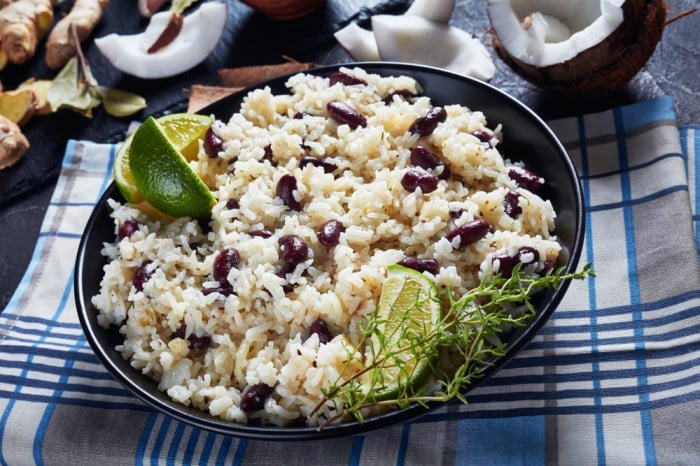
The rice and peas dish is another of Jamaica’s national dishes, often served as a side dish with either curry chicken, goat, or jerk chicken.
The combination of rice and peas is delicious and nutritious, as it provides a good source of protein, fiber, and carbohydrates.
In the Caribbean, when people talk about peas, they refer to beans, specifically kidney beans. Europeans and Americans often confuse them with green peas, which are also popular in the region.
Jamaican rice and peas are usually made with coconut milk, which provides a rich, creamy flavor. Another key ingredient in this dish is scotch bonnet peppers, which add significant heat. Curry chicken with rice and peas is a popular Jamaican food.
4. Ackee and Saltfish

Ackee and Saltfish is a traditional Jamaican food that is similar to a scrambled omelet. This dish is typically served for breakfast, but can also be a main course for lunch and dinner.
The ackee fruit, which is native to West Africa, was brought to Jamaica by slaves in the 18th century. Ackee is a fruit whose exterior is red and thick with a creamy and nutty flavor.
When cooked, the ackee fruit has a velvety, custard-like texture. It has an exotic flavor that combines perfectly with the flaky and tender saltfish.
Ackee and Saltfish is a Jamaican recipe that is usually made with salt cod that has been soaked overnight to remove the excess salt. The cod is then sautéed with onions, peppers, and tomatoes. The ackee fruit is added to the pan and cooked until soft.
5. Jamaican Beef Patties
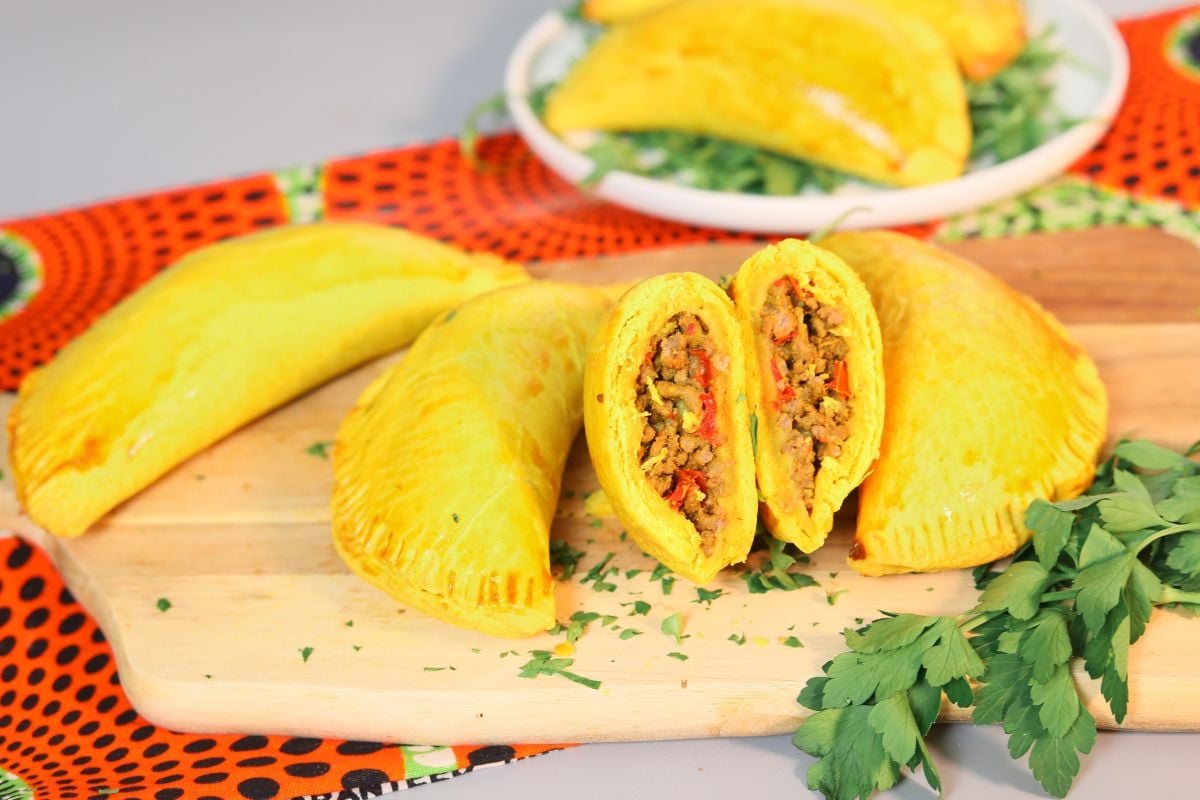
Patties are a type of pastry that is popular in the Caribbean, Latin America, and Southeast Asia. These are an iconic and beloved Caribbean snack. The golden, flaky beef patties are filled with an irresistible spicy mixture of beef and aromatic spices.
Jamaican beef patty is typically made with beef but can also be made with chicken, lamb, fish, or vegetables. The Jamaican beef patty is fun as a portable snack or appetizer but can also be eaten as a main course.
Jamaican beef patties are typically served with a spicy Jamaican scotch bonnet pepper sauce. The best Jamaican beef patties are found in Jamaican bakeries and street stalls. One of the best Jamaican foods there is, Jamaican patties are a delectable representation of its vibrant food culture.
6. Callaloo
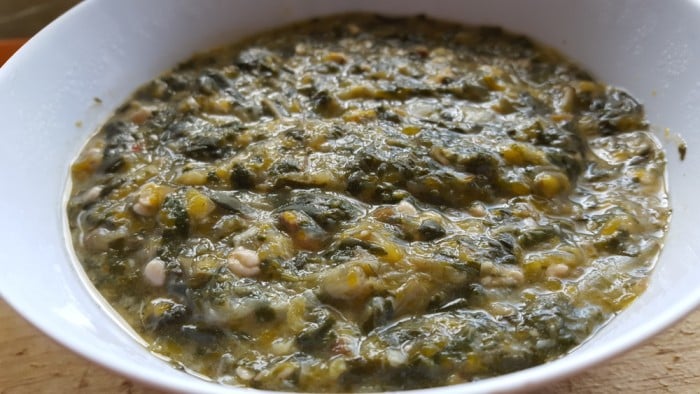
Callaloo is a nutritious leafy soup or stew that is popular in the Caribbean and Africa. It is usually made with shrimp, crab, or lobster. However, it can also be made with chicken, pork, or beef.
Callaloo is typically made with greens such as spinach, chard, collard greens, or kale, which give it a mild bitterness. Other vegetables, such as tomatoes, onions, and peppers, can also be added to the dish. To balance the bitterness, the dish is usually seasoned with thyme, garlic, and scotch bonnet pepper.
Callaloo is a hearty soup that is served with Jamaican rice and beans or cornbread. Its creamy texture can complement fried plantains or Jamaican fried dumplings. Callaloo is a celebrated Jamaican food choice for special occasions such as weddings and funerals.
7. Rum Cake

Jamaican Rum cake is a traditional Jamaican dessert made with Jamaican rum, spices, and fruits such as raisins, cherries, or pineapple. The cake is usually soaked in rum before it is served.
There are many different recipes for rum cake, but the most popular version is made with a pound cake mix. The cake mix is combined with rum, eggs, and oil.
Jamaican Rum Cake, in particular, is made with a dark rum called Jamaican Pot Still Rum. It can be found in most bakeries and supermarkets on the island.
This is a beloved dessert deeply rooted in Jamaican culture. It is associated with celebrations, especially during holidays and weddings. The rum cake is a harmonious blend of richness, fruity sweetness, and warm spices.
8. Fruit Punch

Jamaican Fruit Punch is a popular drink made with fresh fruits, juices, and spices. Pineapple, mango, and orange are the most popular fruits used in the punch. Jamaican Fruit Punch is usually served at Jamaican restaurants, parties, and other special occasions.
Jamaican fruit punch is a delightful and refreshing tropical beverage that represents the flavors of the Caribbean. It is a balance between sweet and tangy flavors with a zesty kick that brightens up the overall flavor profile.
Jamaican rum is the most popular choice for cocktails because of its versatility. Any alcohol can be added, such as vodka, ginger beer, gin, or tequila, for an extra kick.
9. Toto (Coconut Cake)

Toto is a type of coconut cake that is popular among Jamaican desserts in the Caribbean. The cake is an enjoyable dessert with a cup of Blue Mountain coffee.
Toto has a dense and moist texture that is similar to a classic pound cake. The tender bits of shredded coconuts give the cake a pleasant chewiness in every bite.
The shredded coconut is typically mixed with dark rum before adding it to the batter. This gives the cake a delicious traditional Jamaican flavor. Jamaican Toto is usually served at birthday parties, weddings, and other special occasions.
10. Red Stripe Beer

You can’t visit Jamaica without trying the country’s national beer, Red Stripe. This light lager is brewed with Jamaican hops and has a crisp, clean taste. It’s the perfect drink to enjoy on a hot day by the beach.
Red Stripe is widely available throughout Jamaica and can be found in supermarkets, bars, and restaurants. If you want to try something different, order a Red Stripe Light. This low-calorie version of the beer is perfect for those watching their weight.
11. Jamaican Blue Mountain Coffee

Jamaican Blue Mountain Coffee is some of the finest coffee in the world. The coffee beans are grown in the Blue Mountains of Jamaica at an altitude of 3,000 feet. The beans are hand-picked and then slow-roasted to create a rich, full-flavored coffee.
What sets Blue Mountain coffee apart is its complexity. It offers a wide range of flavors, such as nuts, cocoa, and mild floral undertones. The hallmark of Jamaican Blue Mountain coffee is its clean, crisp finish. It does not leave a bitter aftertaste, making this coffee an exceptionally pleasant coffee to savor.
Jamaican Blue Mountain Coffee beans are available in most supermarkets and specialty stores. It can also be ordered online. If you want to try the coffee before you buy it, many cafes in Jamaica offer samples.
12. Escovitch (Pickled Fish)

Escovitch is a type of pickled fish that is the most popular Jamaican food. It is made with fresh fish, vinegar, onions, Scotch Bonnet peppers, and spices. The fish is usually marinated for several hours before it is cooked.
Escovitch is usually prepared with snapper, grouper, or jack mackerel, the most common fish on the island. To marinate it, vinegar, onion, spices, and fresh herbs are used, resulting in an excellent Caribbean flavor. You can also add ginger, bay leaves, garlic and thyme.
Escovitch can be served as an appetizer or main course that is often served with rice and beans or fried plantains. If you want to try something different, try Jamaican Escovitch Tostones. These are tostones (fried plantains) that are topped with Escovitch.
This way of marinating food arrived in America during the Spanish conquest. That is why Escovitch, a traditional Jamaican food, was found in other Latin American countries.
13. Bammy (Cassava Cake)
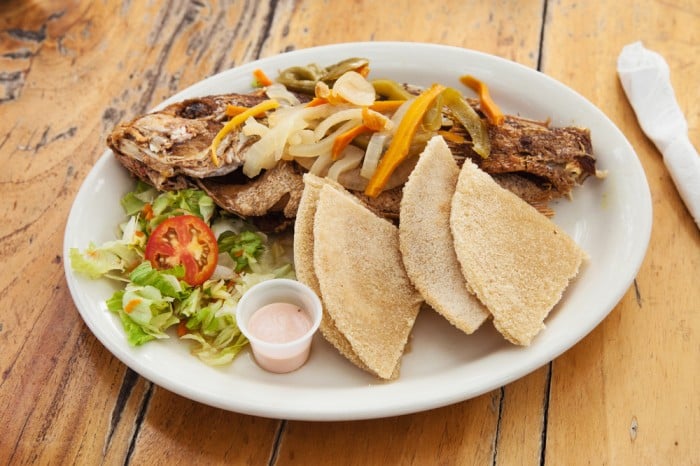
Bammy is a Jamaican dessert of ancestral origins and is made with cassava. Cassava is a starchy root vegetable that is a staple in Jamaican cuisine. In addition to cassava, it is usually seasoned with scotch bonnet peppers, black pepper, and coconut milk before frying.
Its origins are related to the Arawaks, the main inhabitants of the island in the pre-Columbian era. After the conquest, this flattened bread became the essential food of Jamaicans living in rural areas for many years.
Bammy has a mild, nutty flavor that pairs well with a variety of dishes. In some Jamaican dishes, the recipe for bammy includes shredded coconut, which gives it a delicious tropical twist.
The outer layer is golden brown and crispy, while the center has a chewy texture. When soaked in liquid or cooked in a sauce, bammy can absorb the moisture and flavors well.
14. Run Down (Fish Stew)
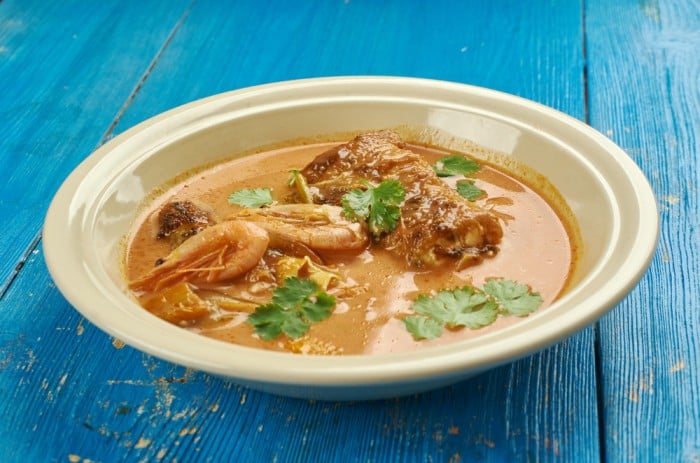
Run Down is a traditional Jamaican dish with fish, coconut milk, and spices. This stew is usually made with salted hake or horse mackerel, although salted cod may also be used.
As an accompaniment, it is served with dumplings or baked breadfruit. It can also be served with plantains, Jamaican rice and peas, or boiled yams.
The dish gets its name because the ingredients are “run down” into a pot. This results in a stew-like dish that is hearty and filling.
Despite its African roots, run down is not widely consumed in Africa. Variations exist in Tobago, throughout South America, and Central America, particularly in regions where many Jamaicans live.
15. Jamaican Porridge

Jamaican Porridge is a type of porridge made with cornmeal, plantains, oatmeal, coconut milk, condensed milk, and spices.
The cornmeal is boiled in water or milk until thick and creamy. Then, spices such as cinnamon, nutmeg, and vanilla are added.
Jamaican Porridge is usually served with bananas, raisins, or nuts. If you want a sweeter porridge, you can add honey or sugar. The secret to making it perfect is to stir continuously to avoid forming unpleasant lumps.
16. Gizzadas (Coconut Tart)

Gizzadas are a type of Jamaican coconut tart. A Jamaican dish made with grated coconut, condensed milk, spices, and flour. They are usually served as a dessert or snack and can be found in almost any bakery or pastry shop on the island.
Gizzardas are an explosion of coconut flavors with a hint of warm spices. It’s definitely on the sweeter side with a flaky pastry crust. The coconut filling is chewy and moist. Every bite is a satisfying treat with a cup of coffee.
Gizzadas can be served plain or with ice cream, whipped cream, or chocolate sauce. You can bake them without the crust if you want a healthier version. It is an iconic Jamaican dessert that is enjoyed during holidays.
17. Stamp and Go (Saltfish Fritters)

Stamp And Go, also known as Jamaican Saltfish Fritters, is a popular snack in Jamaica. It is often enjoyed as a breakfast dish or a quick bite on the go. This dish utilizes salted codfish as the star ingredient, first soaked to reduce its saltiness, then flaked into small pieces.
The cod is then mixed into a batter of flour, baking powder, onions, and a splash of Scotch Bonnet pepper for a spicy kick. These ingredients create a flavorful blend. They are deep-fried until golden brown, resulting in a crispy exterior and a soft, fluffy interior.
18. Solomon Gundy (Pickled Fish Pate)
Solomon Gundy is a treasured authentic Jamaican cuisine, often likened to a pickled fish pate. This specialty is traditionally made from herring, though other fish types can also be used.
The fish undergoes a curing process in a delightful marinade featuring vinegar, onions, and hot peppers, creating a richly spiced, uniquely Caribbean flavor profile.
Though enjoyed year-round, Solomon Gundy is special in Jamaican Christmas festivities. It’s often served in Jamaican restaurants spread on crackers as an appetizer, or used as a spice in various dishes, adding a touch of the sea to any meal.
19. Sweet Potato Pudding

Venturing into the realm of Jamaican foods, Sweet Potato Pudding is a true island classic. This delightful dessert is made from grated sweet potatoes and a medley of spices, sugar, and coconut milk.
The mixture is then slowly baked into a moist, decadently sweet pudding with a unique tropical twist.
Often called “hell a top, hell a bottom, and hallelujah in the middle” by locals, the pudding is traditionally slow-cooked on a coal stove, with hot coals both above and below the baking tin, resulting in a heavenly middle.
Sweet potato pudding is renowned for its sweet, earthy flavor, and contrasting textures. It’s usually served sliced, warm, or at room temperature, offering a sweet ending to any Jamaican meal.
20. Oxtail Stew

The flavorful and hearty Oxtail Stew is one of the best Jamaican dishes. This stew is the epitome of comfort food. The oxtail is slowly simmered in a rich blend of herbs, spices, and various vegetables, such as butter beans, carrots, and bell peppers until it becomes tender and the flavors meld together perfectly.
The secret to the stew’s deep, robust flavor is browning the oxtail before the slow simmering process begins. This step ensures a caramelized exterior that adds a rich depth to the overall dish.
21. Pepperpot Soup

A quintessential Jamaican food, Pepperpot Soup, encapsulates the island’s bold flavors and culinary creativity.
This hearty soup is brimming with diverse meats such as pork, beef, and sometimes even goat. The heart of the soup, however, is the use of callaloo leaves or spinach, which provides a unique earthy flavor and a beautiful deep green hue to this tasty meal.
This best Jamaican food is seasoned with aromatic fresh herbs and spices. The essential ingredient – Scotch Bonnet pepper- infuses a lovely, spicy kick. Accompanied by fried fish, dumplings, sweet potatoes, and yams, the soup turns into a wholesome, filling meal.
22. Mannish Water

Despite its peculiar name, Mannish Water is a traditional Jamaican food. This goat soup is known for its invigorating properties. Traditionally served at large gatherings, Mannish Water is said to be a potent aphrodisiac and is a must-have at weddings.
This soup is one of the best Jamaican cuisine. It is usually prepared using the parts of the goat that are often discarded, such as the head, intestines, and feet.
The soup is seasoned with a variety of spices. Importantly, Scotch Bonnet peppers, yam, potatoes, and bananas are also added for substance. The unique blend of ingredients results in a deeply flavored, spicy, and rich broth.
Conclusion
In conclusion, Jamaican cuisine is a vibrant tapestry of flavors that reflect Jamaica’s rich history and cultural diversity. From the spicy fish soup to the Jamaican patties, the food is an experience, a celebration, and a connection to the heart and soul of the island.
Remember to embrace the flavors, traditions, and stories as you recreate these dishes in your kitchen. This cuisine reflects the resilience and creativity of the Jamaican people, who have transformed the humble ingredients into culinary treasures!



